#fuel cell market research
Explore tagged Tumblr posts
Text
Fuel cell Market - Forecast(2024 - 2030)
Fuel Cell Market Overview:
According to the International Trade Center (ITC), the trade of fuel cells that are particularly used in electric motors and generators was valued at $19.2 billion in 2018. Fuel cells have diverse domestic and commercial applications as they are indispensable parts of many machines in which chemical energy is converted into electrical energy. The fuel cell market was valued at $4.5 billion in 2018 and is projected to grow at a compound annual growth rate (CAGR) of 15.38% from 2019 to 2025.
The federal governments of countries such as the U.S. and Canada are supporting the private companies that manufacture fuel cells. The fuel cell market is observing funding opportunities from the US Department of Energy (DOE), and the Fuel Cell Technologies Office (FCTO) that belongs to the Office of Energy Efficiency and Renewable Energy. On March 1, 2019, the DOE announced a $51.5m funding for research in technologies that power trucks and off-road vehicles. Similarly, other countries in North America had observed soaring sales of fuel cells recently. The North America fuel cell market held 33.27% share of the global market in 2018.
Fuel Cell Market Outlook:
Fuel cells such as hydrogen fuel cells, solid oxide fuel cells, and methane fuel cells are electrochemical cells that convert chemical energy into electrical energy. Fuel cell energy is required in domestic and commercial sectors, and it is also used to charge the fuel cell vehicles.
The application segment that is poised to create the most lucrative opportunities to the vendors in the fuel cell market is the stationary power application segment. This is mainly attributable to the application of fuel cells in generators, which are important standby electricity suppliers. Furthermore, there is expected to be an augmented application of fuel cells in the uninterruptible power supply market, which had a valuation of $10.5 billion to $11 billion in 2018, and the segment is poised to observe a substantial CAGR of 4% to 5%, which will further propel the fuel cell market. The stationary segment will observe a healthy CAGR of 16.94% through 2025.
Request Sample
Fuel Cell Market Growth Drivers:
· The Application of Fuel Cells in the Automotive Industry –
According to the International Organization of Motor Vehicle Manufacturers (OICA), the number of vehicles manufactured in 2018 was 95,634,593. Furthermore, the future will observe an increment in the manufacturing of automobiles, and more so with the advent of electric vehicles, autonomous & semi-autonomous vehicles, and self-driven trucks. The growth prospects in the automotive sector will escalate the fuel cell market revenue in the future.
· Commercial Applications Expanding the Fuel Cell Market Size –
A variety of fuel cells such as proton exchange membrane fuel cells, solid oxide fuel cells, solid polymer fuel cells, phosphoric acid fuel cells, and alkaline fuel cells are used in commercial buildings. Given that motors and generators have prominent applications in commercial buildings, the segment happens to be a lucrative fuel cell marketplace.
Inquiry Before Buying
Fuel Cell Market Trends –
· Latest Developments – Fuel cell catalyst technology has been constrained by two hurdles that include manufacturing costs and durability. However, there are innovations in the fuel cell market, and there will be alterations in the fuel cells stack technology. These innovations will significantly reduce the costs by reducing the usage of precious metals and improving the longevity of fuel cells through innovative designs in catalyst layers.
· In November 2018, Panasonic decided to commercialize the hydrogen fuel cell generator in order to accelerate initiatives to achieve a sustainable society by utilizing hydrogen energy. This trend will be adopted by a lot of organizations, and further drive the hydrogen fuel cell market and hydrogen market as well.
· In December 2018, Hydrogenics Corporation was awarded a contract for the design and supply of fuel cell power modules for a new lightweight aircraft. This will position the company in the aircraft fuel cells segment.
Fuel Cell Market Challenges –
Even though fuel cells are found to be excellent alternatives to internal combustion engines that aren’t environment-friendly, fuel cells are yet to penetrate various industries and replace the conventional form of energy, which is limiting the expansion of the fuel cell market. Furthermore, the vendors are striving to optimize the pricing according to the end-user criteria in order to thrive on the demand, which is picking up pace. Another factor that is constraining the growth of the customer-base is the reliability of fuel cells. However, manufacturers are making hefty investments into R&D, and the future is poised to observe some innovations that will disrupt the fuel cell market.
Schedule a Call
Fuel Cell Market Key Players Perspective –
The major players that are battling for the fuel cell market share are Ballard Power Systems Inc., Toshiba Corporation, Panasonic Corporation, Horizon Fuel Cell Technologies, Hydrogenics Corporation, Fuel Cell Energy, Inc., Ceramic Fuel Cells Limited, Aisin Seiki Co., Ltd., Doosan Fuel Cell America, Nuvera Fuel Cells, SFC Group, Bloom Energy, Nedstack Fuel Cell Technology B.V., Plug Power, UTC Power Corp., and Arcola Energy.
Fuel Cell Market Research Scope:
The base year of the study is 2018, with forecast done up to 2025. The study presents a thorough analysis of the competitive landscape, taking into account the market shares of the leading companies. It also provides information on unit shipments. These provide the key market participants with the necessary business intelligence and help them understand the future of the fuel cell market. The assessment includes the forecast, an overview of the competitive structure, the market shares of the competitors, as well as the market trends, market demands, market drivers, market challenges, and product analysis. The market drivers and restraints have been assessed to fathom their impact over the forecast period. This report further identifies the key opportunities for growth while also detailing the key challenges and possible threats. The fuel cell market research report also analyzes the applications of the devices in the commercial, consumer product, and automobile sectors.
Buy Now
Fuel Cell Market Report: Industry Coverage
This report also documents the product based on types, which include metal hydride fuel cell, DFAFC, and UMFC.
The fuel cell market report also analyzes the major geographic regions as well as the major countries in these regions. The regions and countries covered in the study include:
North America: The U.S., Canada, Mexico
South America: Brazil, Venezuela, Argentina, Ecuador, Peru, Colombia, Costa Rica
Europe: The U.K., Germany, Italy, France, the Netherlands, Belgium, Spain, Denmark
APAC: China, Japan, Australia, South Korea, India, Taiwan, Malaysia, Hong Kong
Middle East and Africa: Israel, South Africa, Saudi Arabia
#fuel cell market#fuel cell market size#fuel cell market shape#fuel cell market forecast#fuel cell market analysis#fuel cell market report#fuel cell market research#solid oxide fuel cells#membrane fuel cells\
0 notes
Text
Fuel Cell Market Product Driving Factors, Capacity and Growth Rate Analysis to 2030
The global fuel cell market size was estimated at USD 7.35 billion in 2023 and is expected to grow at a compound annual growth rate (CAGR) of 27.1% from 2024 to 2030. Increasing demand for unconventional energy sources is one of the key factors driving the growth. Growing private-public partnerships and reduced environmental impact are expected to propel the demand. Governments across the globe…
#Fuel Cell Industry Research#Fuel Cell Market Analysis#Fuel Cell Market Overview#Fuel Cell Market Share
0 notes
Text
#Residential Fuel Cell Market#Residential Fuel Cell Market Research#Residential Fuel Cell Market Analysis#Residential Fuel Cell Market Forecast#Consumer Goods & Retails#marketing
1 note
·
View note
Link
#adroit market research#global fuel cell market#alkaline fuel cell (afc)#low temperature fuel cells (lt
0 notes
Link
#market research future#microbial fuel cells company#microbial fuel cell industry#microbial fuel cell analysis#microbial fuel cell report
0 notes
Text
Methanol Market: Current Trends and Future Outlook| MarketsandMarkets™
Methanol, also known as methyl alcohol, is an organic compound that is composed of one carbon atom, two hydrogen atoms, and one oxygen atom (CH3OH). It is a clear and colorless liquid that is highly flammable and has a distinctive odor. Methanol is used in the production of a variety of industrial and commercial products, including formaldehyde, acetic acid, methyl tert-butyl ether (MTBE), and…

View On WordPress
#Covid 19 Impact on Methanol Market#Fuel Cell#global methanol demand#Global Methanol Market#methanol commodity price#Methanol Industry#Methanol Market#Methanol Market Analysis#Methanol Market Demand#Methanol Market Forecast#Methanol Market Growth#methanol market outlook#methanol market price#methanol market report#Methanol Market Research#Methanol Market Share#Methanol Market Size#methanol spot price#Renewable Energy#renewable methanol market
0 notes
Link
#adroit market research#global fuel cell market#alkaline fuel cell (afc)#low temperature fuel cells (lt
0 notes
Text
#Fuel Cell Technology Market#Fuel Cell Technology Market Trends#Fuel Cell Technology Market Growth#Fuel Cell Technology Market Research#Fuel Cell Technology Market Industry#Fuel Cell Technology Market Reports
0 notes
Text
Wasteland Survival Guide: The Institute, Fusion Reactors, and M.I.T.'s Actual Basement
It's that time again. Periodically I make unreasonable longposts about Fallout-related topics (it's a good way to keep track of fic research). Today I'm tackling nuclear fusion, the Institute, and the real-world Massachusetts Institute of Technology's basement.
Yeah, Yeah, M.I.T. is the Institute, We've All Seen - Wait, What Do You Mean, "The Vault Laboratory?"
M.I.T. - the Massachusetts Institute of Technology - is a highly exclusive research university with a well-deserved reputation for hosting brilliant minds.
It also got its serial numbers filed off in order to host the in-game Institute. Why? Probably because of all the very real research into robotics, artificial intelligence, and power armor (no really). And because M.I.T. is actually doing now what the Institute tries to do in-game with nuclear fusion.
And, of course, because of the vaults in the basement.
You know what? I'll just start at the top...Read on below.
I'll be focusing on fusion-related research in this post, and comparing in-game Institute work on fusion to what's actually happening over at M.I.T. (We'll get to the Media Laboratory and robotics and AI and the, uhm, power armor stuff in a separate post. Or three.)
all actual M.I.T. researchers/faculty/students and/or nuclear physicists have my sincere apologies, I don't know shit about shit but I'm doing my best
I Didn't Sign Up for a Physics Class, but Okay
Here's the thing about nuclear fusion generators - y'know...the ones powering nearly** the entirety of pre-war in-game America?
Including self-contained, miniaturized reactors (fusion cores, fusion cells, microfusion cells, Corvega engines, assaultron and robobrain power supplies, recharger weapons, G.E.C.K.s, etc.) and full-scale reactors (powering vaults, the Lucky 38, the Prydwen (and Rivet City before Maxson Happened), missile silos, etc.)...?
We don't have them yet.
Of course we have nuclear power generation, what are you talking about?
Yes - but nuclear power plants currently operating use fission reactors! Fusion reactors, though? Well...

For the pre-war in-game universe, even more than for us, that fuel-to-energy ratio would have been absurdly important. Companies rushed to implement fusion for damn near every possible use, but waited until the Resource Wars left them no other choice. "No more (viable) oil reserves? Well, shit. Fusion it is."
Because of this, by October 23, 2077, pre-war Western markets were still somewhat new to adopting miniaturized nuclear fusion reactors.
For instance, Chryslus' first fusion vehicles - intentionally reminiscent of the absolutely wild Ford Nucleon concept car dreamed up in 1957 - came to market in 2070, less than a decade before the nuclear exchange.
As for the other benefits of nuclear fusion...Atom knows the in-game universe could do with less radioactive contamination:

It is no wonder the Institute wants to get the reactor in their basement up, running, and running better than originally designed.
Real-life M.I.T. is no stranger to running fusion reactors - they've been at it since the late '60s - but as it turns out, they are currently also "building a better mousetrap," and if they succeed they will be achieving all the Institute would hope for in clean energy production - without the moral deficit.
If nuclear fusion is so great, why aren't we using this technology yet IRL?
Because - and I cannot stress this enough - we are attempting to levitate bits of the Sun inside a donut to make really hot things boil water* so steam will turn a fan attached to a dynamo to power light bulbs.
*(there are two other ways to generate power using this heat)
Naturally...this comes with some complications.
We know fusion reactors can be the most energy-efficient form of power generation - we just need better reactors. That's where M.I.T. comes in.
The biggest problem right now is efficiency:
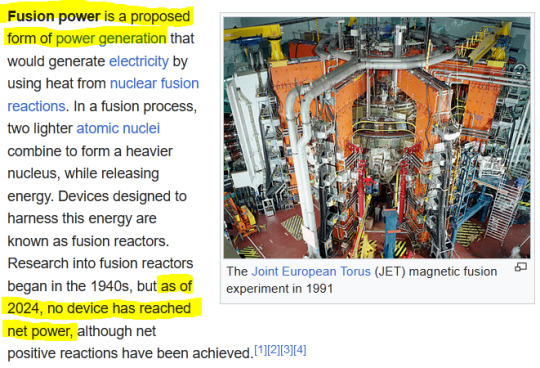
TL;DR - as of April 2024, all fusion reactors as a matter of course still consume more power to run than they are able to produce (meaning they do not reach "breakeven"). Many cutting-edge reactors also require tritium (very rare) as well as deuterium (very common) fuel.
We did not even see a fusion reaction that reached "breakeven" for power production until December of 2022. That reaction occurred at the National Ignition Facility in California, and their results just passed peer review in February of this year (2024).
Several in-progress reactors aim to improve on this, including ITER (the combined work of dozens of nations) in France, and SPARC: the new reactor under development by Mass Fusion Commonwealth Fusion Systems and M.I.T.'s Plasma Science and Fusion Center (PSFC).
Another big problem with this technology is that it involves plasma.
Plasma, as a particular song reminds us, is what the Sun is made of and The Sun Is Hot. That means plasma carries some very real 'we're-losing-structural-integrity, the-warp-core-is-breaching' risks, and we must jump through all kinds of hoops to work with it.
Why are we shoving the Sun inside a donut, again?
The most well-funded, well-researched way of smashing atoms together involves plasma and magnetic confinement fusion.
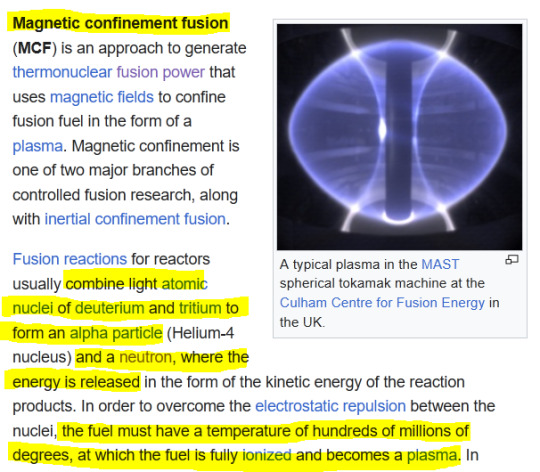
This shit is beyond cool. It may also look very familiar:
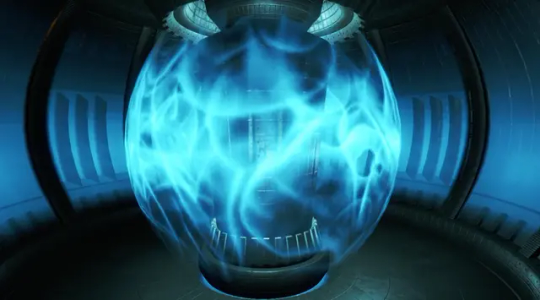
In-game, the Institute is trying to get what appears to be a spherical tokamak reactor up and running.
Bethesda's choice of reactor was no coincidence: M.I.T. operated the Alcator C-Mod, a spherical tokamak, while Fallout 4 was under development - but that reactor could not achieve "breakeven" IRL, and per Shaun's in-game dialogue, the fictional Alcator C-Mod couldn't either. (Weird given the miniaturized fusion devices everywhere in-universe, but okay, Shaun.)
However, M.I.T. stopped operating that reactor in 2016, a year after Fallout 4's release. SPARC, their planned replacement reactor actually has the sort of power potential we see in-game - and they aim to bring fusion power to market in this decade.
M.I.T., right now, in real life, is doing exactly what you're asked to help the Institute do in-game: build a fusion reactor that surpasses "breakeven."
What the hell is a tokamak and why does it look like half of a Star Trek warp core?
Your typical tokamak reactor is a great big donut-shaped vacuum chamber (the torus), traditionally surrounded by AT LEAST three sets of electromagnets (sometimes many more). M.I.T.'s design for the new SPARC reactor is a bit different, but let's start with the basics.
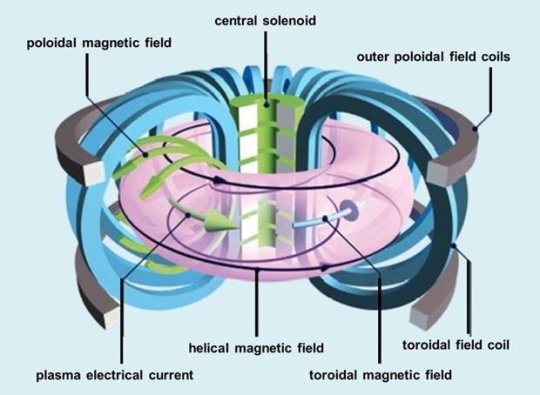
Why so many magnets?
Because plasma, being Literal Sun Matter, cannot come into contact with the torus containment walls or it will instantly burn through. (This happened in France in 1975. Following initial "well, fuck"s and a couple years' repairs, the logical next step was to publish a paper about it.)
The magnetic fields work to heat the plasma and provide current drive (keep electrons moving in a consistent direction through the plasma and around the torus), while also keeping it from touching anything, preventing a "warp core breach." I'll take a stab at explaining it but the Department of Energy probably does it better.
Meet the magnets:
Toroidal field magnets (blue, above): These enormous D-shaped magnets wrap around and through the torus, conducting an electrical current. This creates a magnetic field that keeps plasma from drifting horizontally into the containment walls.
Central solenoid (green, above): Inside the "donut hole" sits a massive, stacked electromagnet that generates enough electromagnetic force to launch two space shuttles at once. This heats the fuel to about one hundred million degrees Celsius so that it reaches plasma state, and helps "drive" the plasma current around the torus. (Radiofrequency or neutral beam injection heating/drive may be used as well for reactor prototypes aiming for power generation, because current drive from just the solenoid isn’t practical for continuous operation.) The central solenoid also creates another magnetic field called the "poloidal field," which "loops" around the plasma like a collar to prevent it from drifting vertically into the walls. The strongest central solenoid in existence was made for the ITER reactor...by General Atomics.
Outer poloidal field magnets (grey, above): A third set of electromagnets "stacks" up the outside of the torus, and helps maintain and adjust the poloidal field.
Together these three sets of magnets force the plasma to "float" inside the torus, shape it, and provide current drive. The stronger the magnetic field, the higher the reactor's power output.
Okay, and then what?
Given sufficient heat and drive/stability, the plasma fuel mixture undergoes fusion.
Neutrons released during fusion have plenty of kinetic energy (the kind of energy a kickball has midair before it hits you in the face), but no electric charge.
Since magnetic fields only affect negatively or positively charged particles, neutrons completely ignore the fields, sailing straight through and slamming into a "blanket" of metal coating the donut's insides. Neutrons passing into the 'blanket" lose their kinetic energy, which is converted to heat and absorbed by the "blanket." (ITER's "blanket" involves a lot of beryllium, which...behaves a bit differently IRL than it does in-game.)
Heat captured by the "blanket" is then used to generate power. For instance, a water cooling system can bleed heat from the "blanket," regulating temperature and creating superheated highly-pressurized steam to run turbine generators.
I notice you described a "typical" tokamak above -what's the atypical option?
Check out SPARC.
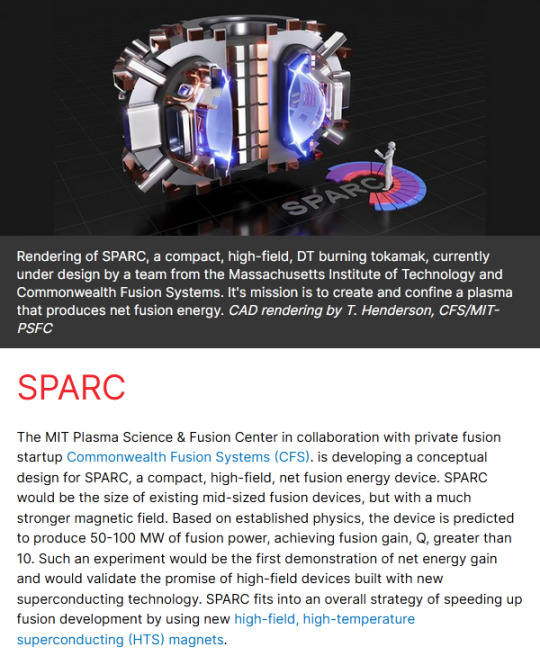
Its huge design departure is that it uses new high-temperature superconducing magnets (most existing types have to be cooled to vacuum-of-space temperatures using something like a liquid helium system to achieve superconductivity, which is a huge power drain) to create a monstrous magnetic field - and its size is tiny in comparison to its projected power output.
Neat. So why did you refer to plasma as a problem?
Well...between the heat and the neutrons, the "blanket," the "first wall" and all plasma-facing surfaces inside the torus take one hell of a beating:

"Neutron degradation of wall surfaces-" "Energy is released in the form of the kinetic energy of the reaction products-" In practical terms, that just means countless neutrons are doing THIS:

...but to the containment wall and other surfaces inside the torus, instead of to Batshuayi's face. And so:

Basically, this stuff breaks fast enough - and the only materials that don't break quickly are rare enough - to create a real barrier to commercial use.
And THIS is one of the problems they're working on solving in M.I.T.'s basement.
Now we can talk about the Vault. FINALLY.
M.I.T. is home to the Center for Science and Technology with Accelerators and Radiation (CSTAR). CSTAR's splash page announces:
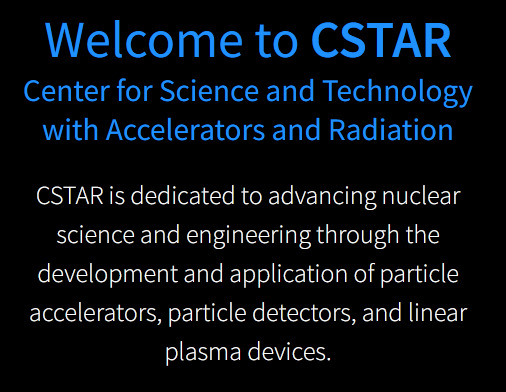
Linear plasma devices? You mean like -
No, not like plasma rifles. Instead of weapons, we're talking about tools being used to solve the "plasma fucking destroys everything it touches" problem.
How does CSTAR do this? They've got CLASS. ...No, really:
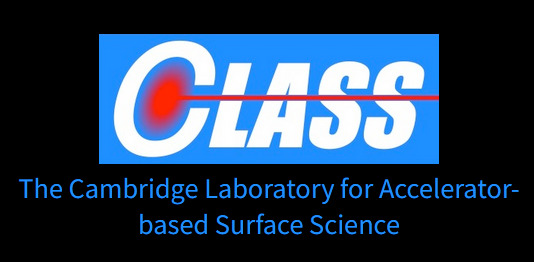
This field is called plasma-surface interaction science, and if you want a really long but very informative read on how CSTAR's work helps move it forward, check this out. It involves the DIONISOS Linear Plasma Device - a "let's shoot it with plasma and see what happens" tool.
CSTAR also works to better undertstand how materials handle radiation damage, and how they behave after becoming irradiated.
And to handle this sort of work, one needs a...
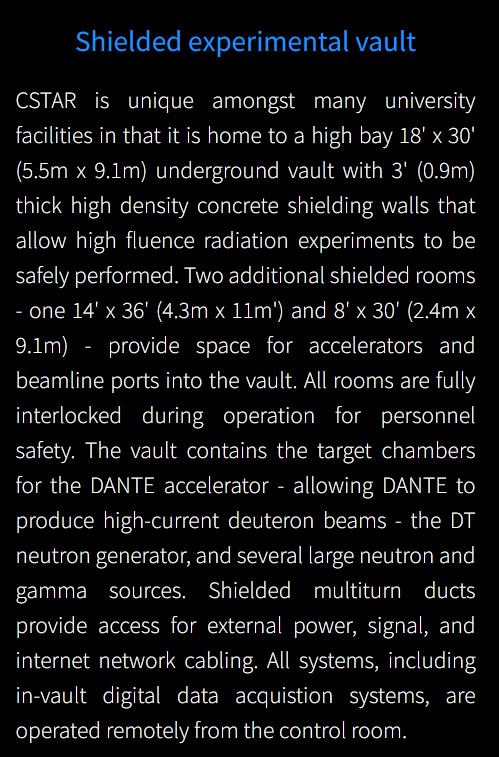
The Vault Laboratory for Nuclear Science "combines high-intensity particle sources, precision particle detection, and a heavily shielded experimental area to create a facility for nuclear research in high-radiation environments." It contains, among other things:
the DT Neutron Generator, which is used in a variety of experiments, including radiation detector development (pretty damned important) and characterization, fast neutron imaging, and material activation (stuff becoming radioactive).
the DANTE Tandem Accelerator, which was "originally designed to produce high neutron yields for use in cancer therapy research."
And that is what's actually going on in M.I.T.'s basement: truth is cooler than fiction.
The takeaways:
Yes, M.I.T. really is building a revolutionary fusion reactor with parts from Mass Fusion Commonwealth Fusion Systems.
Yes, there really is a secure underground facility where incredibly advanced research related to nuclear fusion, radiation detection, irradiated materials, and degradation of materials due to radiation exposure takes place.
Yes, I really would spend eight hours researching nuclear physics instead of doing more dishes. Shoutout to @twosides--samecoin for tolerating my absurd hyperfocus on researching this.
Thanks for coming to my TED talk on what M.I.T. is really doing in its basement.
Tune in next time for M.I.T.'s Media Laboratory, and how it is related to real-world power armor, plus: the relationship between Langley, P.A.M.'s IRL cousin, and Vault 101.
** (Fallout is wildly inconsistent re: how widespread fusion is in-game and when it was developed. I mean we're talking a two-decade spread of inconsistency! And somehow the technology - first available to the military - was then miniaturized and made available to the general public before becoming widespread for commercial power generation? And somehow we both do and don't have impossible cold fusion in game? It's a mess. I reject this reality and replace it with a fish, hence this post. Also, I hate fission batteries. don't talk to me about fission batteries, "fission batteries" are small fission reactors but they are definitely not "battery sized" - the "fission batteries" in-universe are so miniaturized that they are more likely another kind of atomic battery like a radioisotope thermoelectric generator and those are subject to a law of diminishing returns as the fuel decays/not producing a reasonably useful power output after over 200 years due to the isotopes normally used/can be VERY dangerous if the shielding is breached or removed, and - you know what, that's also a whole different post.)
#actual insanity#fallout#fallout 4#why am I like this#nuclear fusion#physics#institute#fallout institute#the institute#worldbuilding#meta#oneifbyland#wasteland survival guide
48 notes
·
View notes
Text
Is Air Pollution linked to Menarche?
This is a summary post of a recent article on menarche (the term for the “first period”). I found it pretty interesting and something to keep an eye out for future research. As usual, continue to use your critical thinking skills, and if you'd like to learn more, read on!

REPORT: Recent research (May 2024) shows that air pollution may be linked to girls starting their periods earlier.
BACKGROUND: • It has been estimated that menarche (the term for the “first period”) now starts up to four years earlier in American girls compared to a century ago. • Decreasing ages for the onset of puberty are more noticeable in lower socioeconomic status and ethnic minority groups (A. Gaskins, associate professor at Emory University in Atlanta, the US). • Puberty is controlled by two systems in the body: the HPA axis and the HPG axis. o HPA: hypothalamic-pituitary-adrenal (i.e., from the hypothalamus in the brain to the pituitary gland beneath the brain and the adrenal gland atop each kidney) o HPG: hypothalamic-pituitary-gonadal (i.e., to the gonads, the testes or ovaries)
THEORIES: • A former belief was that childhood obesity was the only reason for premature puberty since fat cells produce proteins that fuel the HPA and HPG axes. o However, this idea doesn't explain why menarche would start earlier in those without childhood obesity. • Current research indicates that toxins could be affecting the HPA and HPG axes, disrupting their activity. o Toxins include toxic gases expelled into the air from vehicle emissions or manufacturing output. o These gases include: sulfur dioxide, carbon monoxide, nitrogen dioxide, and ozone.
TAKEAWAYS: • Toxins may also be in products that are often marketed to girls (including makeup or menstrual hygiene products, like tampons). • Earlier menarche may be caused by multiple factors, including childhood obesity, environmental/household toxins, and psychosocial factors (like childhood stress) • Overall, it is important to consider menarche ages since earlier ages of onset could lead to poor health outcomes later on
FOR MORE DETAILS: Please refer to the BBC article that this summary post is based on. A. Gaskins, associate professor at Emory University in Atlanta, the US, is quoted in this article and explains about the impact of earlier menarches in girls around the world.
Resource Links https://www.bbc.com/future/article/20240605-how-air-pollution-is-impacting-girls-puberty https://www.ncbi.nlm.nih.gov/pmc/articles/PMC3287288/
Please note this post and site is for information purposes only. It does not provide medical advice, diagnosis, treatment or care. Please contact a qualified healthcare provider if you seek care. Thank you.
2 notes
·
View notes
Text

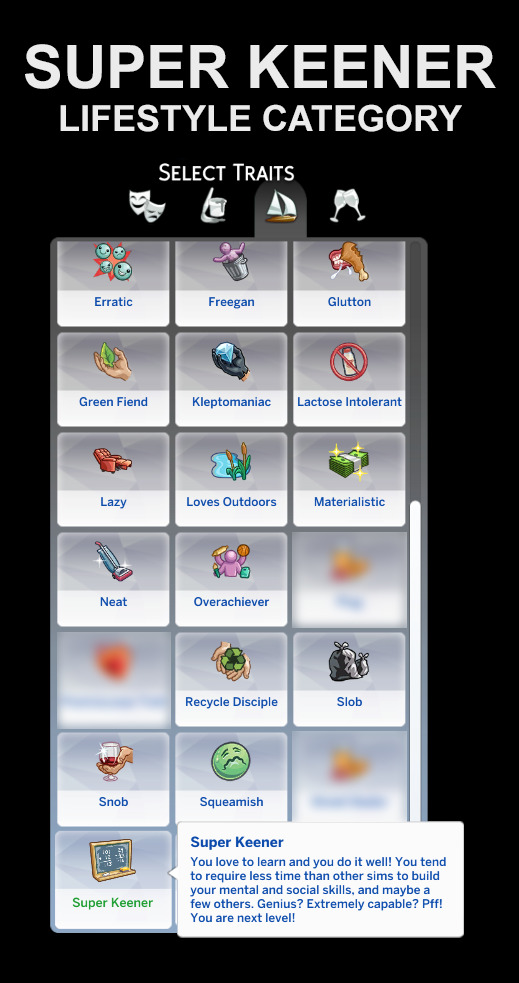

SIMS 4 - SUPER KEENER TRAIT
Now available on CurseForge!
DOWNLOAD FREE HERE
ALL THE INFO:
This version of the Super Keener Trait has been completely refurbished, and deserves its very own post. The trait includes skills, wants, and autonomy from several game packs, including Base Game, but they are not required to use the trait. You simply shouldn't get anything popping up if you don't have the relevant pack.
The Super Keener Trait V6 can still be applied to sims aged child-elder.
CAS trait picker blurb:
"You love to learn and you do it well! You tend to require less time than other sims to build your mental and social skills, and maybe a few others. Genius? Extremely capable? Pff! You are next level!"
Found in Lifestyles category. I know I swap back and forth between categories, but I found this version fits best in Lifestyles.
Right off the bat, your sim will be focused, and they will always have the focused moodlet, because Super Keeners are always ready to learn! I call this, In the Zone.
There is also now a proximity buff called Like minded individual alert! and your Super Keener will be happy to be around other intelligent sims. This happens under certain circumstances, and the list is long, but basically around geeks, geniuses, sims in certain careers at level 3, Honors graduates, etc, as long as your sim is interacting with the sim with one of the required traits, your sim will receive a Happy +1 moodlet.
Now, for the nitty gritty.
⬇️If you'd prefer to just download the trait, feel free to skip all this information!
All affected skils are multiplied by 1.3, which means your Super Keener sim will learn approximately 1/3 faster than other sims without the trait. Here are the skills:
CHILD
ALL MENTAL AND SOCIAL SKILLS
ADULT
ARCHAEOLOGY
CHARISMA
COMEDY
ENTREPRENEUR
FABRICATION
HANDINESS
HERBALISM
HUMANOID ROBOT ENHANCEMENT
LOCAL CULTURE
MEDIA PRODUCTION
MEDIUM
MISCHIEF
PAINTING
PROGRAMMING
RETAIL SALES AND MAINTENANCE
ROBOTICS
ROCKET SCIENCE
VIDEO GAMING
RESEARCH/DEBATE
VAMPIRE LORE
VETERINARIAN
WRITING
Several autonomy/commodity factors have been increased by 1.5, while a few have been decreased by half (0.5). Basically, your sim will be pushed to autonomously do certain actions, or will receive more benefits from certain states.
The three states which have been reduced by half are:
BORED (it will take more for your sim to be bored)
Your sim will want to autonomously do BRO related actions less
ALIEN MEMORY ERASE COOLDOWN (your sim will recover faster)
OWNABLE VET CLINIC CUSTOMER WAIT TIME
The states affected in a positive manner multiplied by 1.5 are:
CHILD AND/OR TEENS
LIFESKILLS AUTONOMY RESPONSIBILITY
LIFESKILLS AUTONOMY CONFLICT RESOLUTION
HOMEWORK
HOMEWORK CLASS A B C D
HOMEWORK PREPARE FOR TEST
HS COMPUTER TEAM
OVERACHIEVER SKILL TRACKER
SCOUTING
VIDEO GAMING AND STREAMING - INCLUDES SIDE HUSTLE
ARCADE MACHINE
MOTION GAMING RIG - ADVENTURE/FAMILY/PUZZLE/SPORTS
EMOTION AUTONOMY FOCUSED
ADULTS
ARCHAEOLOGY TABLE - AUTHENTICATE ARTIFACT/ANALYZE COLLECTIBLE/UNCOVER ARTIFACT/EXTRACT ELEMENT/REFINE CRYSTAL
ARCADE MACHINE PROGRESSION
BOTS ENHANCEMENT PROGRESS
EMOTION AUTONOMY FOCUSED
FESTIVAL FLEA MARKET HAGGLER
CAULDRON CRAFTING PROGRESS
COLLEGE ORGANIZATION SECRET SOCIETY SPRITE FAVOUR
COMPUTER GAME MOD BLICKBLOCK/HILLOCK/INCREDIBLE SPORTS/MARIA SISTERS/REFUGE/ROADRIVAL/SIMS FOREVER RENAMED
COMPUTER VIDEO GAMING - RESEARCH/STREAMS
BUFF READ BOOK FOCUSED LOW
ECO UPGRADE FUEL - FUEL CELL/SIPHONER
INTERROGATION TABLE PROGRESS
METEORITE
MOTION GAMINGRIG - ADVENTURE/FAMILY/PUZZLE/SPORTS
OVERACHIEVER SKILL TRACKER
PROGRAMMING SKILL PROGRESS - APP/FREELANCE/GAME/PLUGIN/VIRUS
SICKNESS SYSTEM - DIAGNOSIS/SURGERY TABLE
TEMPLE TRAP VIEW
TRAIT ALIEN BRAIN POWER
TRAIT AUTONOMY BOOKWORM
TRAIT AUTONOMY GEEK
TRAIT AUTONOMY GENIUS
UNIVERSITY ENROLLMENT APPLICATION TIME
VIDEO GAMING AND STREAMING - INCLUDES SIDE HUSTLE
VIDEO GAMING SKILL - PARTY/PLATFORMER/RACING/RPG
WEREWOLF PACK VALUE - DIPLOMACY
WEREWOLF PACK VALUE - SELF IMPROVEMENT
WRITING SKILL - LITERARY DIGEST
XRAY MACHINE CALIBRATION
CAREER BENEFIT:
ACTIVIST CHARITY
ACTIVIST POLITICIAN
AGENT
BUSINESS
CONSERVATIONIST
CORPORATE WORKER
CRITIC
EDUCATION
ENGINEER
ENTERTAINER
SOCIAL MEDIA
TECH
WRITER
CAREER HACK PAYOUT MULTIPLIER
CAREER SCIENTIST BREAKTHROUGH PROGRESS
CAREER WORK PERFORMANCE INTELLIGENCE DB
-----------------------------------------------------------
WANTS - wants are things that your sim wants to do and receives satisfaction points for. They show up in the little thought bubbles above your sim's head in the UI section of the screen.
ANALYZE BOOK
ANALYZE MICROSCOPE SAMPLE
BE FRIENDLY WITH
BE FUNNY WITH
CHAT WITH
DISCUSS LOGIC PUZZLES
DO PROGRAMMING EARN 100
ENTER GAME TOURNAMENT
GET FOCUSED
GET TO KNOW
HACK ATTEMPT
HACK SCHOOL GRADES
HACK SUCCESSFUL
MAKE A NEW FRIEND
OBSERVE CHESS
PLAY CHESS FOR AN HOUR
PLAY CHESS TRAVEL TO LIBRARY
PLAY COMPUTER GAME
PLAY VIDEO GAMES FOR AN HOUR
PLAY VIDEO GAMES
PLAY WITH TOYS (CHILD)
PRACTICE CODING
PRACTICE SPEAKING
PRACTICE WRITING
READ BOOK
READ BOOK TRAVEL TO LIBRARY
RESEARCH GAMING
SEARCH FOR TRUTH
SKILL UP CHARISMA
SKILL UP COMEDY
SKILL UP HANDINESS
SKILL UP LOGIC
SKILL UP PROGRAMMING
SKILL UP ROCKET SCIENCE
SKILL UP VIDEO GAMING
START NEW COMPUTER GAME
START NEW MOBILE APP
TALK THROUGH ISSUES
TALK ABOUT SPACE
TRACK SATELLITE
TRAVEL TO LIBRARY
Whew! You made it to the end 😁 Now go grab the Trait!
#super keener#ts4 super keener#sims 4 super keener#ts4 trait#sims 4 trait#curseforge#ts4 curseforge#sims 4 curseforge#super keener v6
12 notes
·
View notes
Text
Trucking in Canada: Salary, Top Trucks, and Leading Trucking Companies

In this comprehensive article, we delve into various facets of the Canadian trucking industry. From truck driver salaries and the best truck brands to prominent trucking companies, we've got you covered.
Truck Driver Salaries in Canada
In a continuation of our previous article on becoming a truck driver in Canada, we now explore the salary prospects in this profession. Trucking in Canada not only offers a chance to traverse the vast expanse of the Great White North but also provides an attractive income. Even newcomers to Canada can consider a career in trucking.
How much do truck drivers make in Canada?
With a combination of experience and qualifications, truckers across Canada can earn annual incomes ranging from $48,750 to $82,875 CAD. Several factors influence these earnings, including the driver's skill level, training, years of experience, language proficiency in English and French, and the province of operation.
The average salary for a truck driver in Canada stands at $49,718 CAD per year, equivalent to $25.50 per hour. Entry-level positions typically start at $34,125 CAD per year. Interestingly, reports indicate a growing shortage of truck drivers in Canada, with projections suggesting a shortage of 25,000 truck driving positions by 2023. This increasing demand has led to a lower unemployment rate for truck drivers, which was just 3.3% in 2020, significantly below the national unemployment rate of 5.8% at the same time. Below, we provide an overview of average salaries for truck drivers in various Canadian provinces.
Best Semi Trucks in Canada
Given Canada's diverse geography, from rugged mountainous terrains to flat prairies and dense forests, trucks operating in the region must be dependable and adaptable. This is particularly important for trucks that may cross into the United States. Here are some highly reliable commercial truck brands that cater to the needs of owner-operators and large fleets in Canada:
1. Volvo
Volvo, one of the largest commercial truck brands in Canada, commands a 13.9% market share in the country. Known for innovation, Volvo has been focusing on autonomous trucks and electric vehicles. Their trucks feature advanced connectivity through telematics data, enabling seamless communication between vehicles on the road. The in-cab interiors offer comfort, and remote diagnostics enhance the ease of driving. Fleet owners can diagnose and troubleshoot issues through a dedicated Windows app.
2. International
In 2018, International trucks accounted for almost 36% of Class 7 truck sales in Canada. Renowned for reliability, International has been working to improve fuel efficiency and vehicle uptime. Their 2020 International LT Series aims to enhance vehicle aerodynamics, reducing the tractor-trailer gap and improving roof fairings to achieve an 8.2% fuel economy improvement.
3. Freightliner
With 75 years of experience, Freightliner stands out with its Detroit powertrain, which optimizes engine, transmission, and axle coordination for improved efficiency. The company is actively researching ways to reduce trucking emissions by transitioning some of their semi-trucks from diesel engines to hydrogen fuel cells.
4. Peterbilt
Peterbilt trucks are known for their comfort, making them a preferred choice for long-haul drivers. SmartAir technology helps save fuel, while Smartlinq remote diagnostics ensure driver safety and quick issue resolution. In 2020, Peterbilt began limited sales of electric vehicles, with plans to steadily increase their electric fleet.
5. Mack
Mack has a century-long history of producing commercial trucks sold in 45 countries. It's the largest manufacturer of Class 8 trucks in North America. Mack trucks excel in diverse climate zones, featuring Absorbent Glass Mat batteries designed for temperature fluctuations and maximizing fuel efficiency, often utilizing natural gas instead of diesel.
6. Kenworth
Kenworth is also exploring hydrogen fuel cell technology for its Class 8 commercial trucks. In collaboration with Toyota, they aim to run 10 of their T680 trucks on hydrogen fuel cells with zero emissions. These aerodynamic trucks boast a comfortable sleeper cab and top-notch infotainment and navigation systems.
For more detailed insights into these truck brands, read our article on the "6 Best Semi Truck Brands for Owner Operators."
Finding a Good Used Commercial Truck in Canada
While the aforementioned truck brands are impressive, commercial trucks represent a significant investment for trucking businesses. To reduce upfront costs, consider purchasing a used truck. However, before making such a decision, it's crucial to assess your business requirements, budget, and the following factors:
History, Maintenance, and Accident Checks
Delve into the truck's history and understand why the current owner is selling it. Examine maintenance and repair records diligently, paying particular attention to oil change records, which can impact engine longevity. Check for any past accidents, their nature, extent of damage, and replaced parts.
Quality Checks
Inspect the truck for physical damage, including rust, both on exterior surfaces and within the vehicle. Bumps or imperfections on painted surfaces, especially the roof, may indicate underlying rust issues. Vigilance against physical damage is essential.
Mileage Checks
Mileage is a key indicator of a truck's overall quality when considered alongside other factors. Understanding the engine model can help determine when an engine rebuild may become necessary.
Horsepower and Towing Capacity Checks
Assess the engine's horsepower and towing capacity to ensure they align with your business's specific towing requirements. Different operations may necessitate varying levels of power.
Purchasing a truck is a significant decision, and these checks can help ensure the truck's long-term viability and cost-effectiveness.
Largest Trucking Companies in Canada
In 2018, the Canadian trucking industry generated a substantial revenue of $39.55 billion CAD, driven by nearly 63.7 million shipments. Larger trucking companies typically operate nationwide, offering drivers diverse experiences and better pay, equipment, and benefits. Here are a few of the largest trucking companies in Canada:
1. TFI International Inc.
Headquartered in Montreal, Quebec, TFI International operates through four business segments, providing a wide range of transportation and logistics services, including truckload, LTL, dedicated contracts, expedited shipments, intermodal transport, temperature-controlled hauling, bulk shipments, tankers, and warehousing.
TFI International's strategic approach allows its subsidiaries to serve regional markets independently while granting the parent company access to broader markets. It boasts the largest share in Canada's LTL business and is Canada's largest trucking fleet.
2. Mullen Group
Mullen Group, a significant player in the Canadian trucking industry, operates various trucking companies, including S. Krulicki & Sons Ltd. Its services extend throughout Canada and the continental United States, encompassing LTL, logistics, warehousing, and distribution.
3. Day & Ross
Founded in 1950, Day & Ross has grown to become a key player in the Canadian trucking landscape. Acquisitions and growth have expanded its presence across North America, offering a comprehensive range of services, including LTL, temperature-controlled delivery, and more.
4. Bison Transport
Established in 1969 and based in Winnipeg, Bison Transport has evolved into a major trucking company. With key terminal hubs across Canada, Bison Transport specializes in cross-border truckload transportation, servicing 48 U.S. states.
2 notes
·
View notes
Text
25 Most Quirky Facts About Coffee That Will Blow Your Mind

What Are The Quirky Facts About Coffee? Quirky Facts About Coffee: Coffee Drinkers Live Longer Than Non-Coffee Users. Research shows moderate intake (about 3–4 cups per day) may lead a person to a longer life ( Harvard Health Publishing ). Coffee may reduce the risk of cardiovascular disease, type 2 diabetes, and Parkinson's. Two chemicals in coffee, caffeic, and chlorogenic acid, reduce inflammation. They increase the level of antioxidants in the body and decrease oxidative stress within cells. These acids in the coffee can slow down and prevent cell damage by reducing free radical activity. Decaf Does Not Mean Caffeine-Free. An eight-ounce brewed cup of decaf coffee contains two to 12 milligrams of caffeine based on a Mayo Clinic study. A standard cup of coffee has between 95 and 200 milligrams of caffeine, while a can of cola contains between 23 and 35 mg. Decaffeinated coffee comes from a chemical process where the caffeine is taken out of the beans. These coffee manufacturers then sell the caffeine to soda and pharmaceutical companies. Drinking decaf coffee fuels the soda industry.

Decaf Coffee Is NOT Caffeine Free Coffee Wasn’t Always A Drink, Coffee Was Originally Chewed. Before people learned how to brew coffee, east African tribes mixed coffee berries with animal fat and chewed them as food. They would also ferment the pulp to make a wine-like drink.

Coffee Was Consumed As Food Originally Drinking Coffee Was Once Punishable By Death! In 1511, Mecca rulers believed coffee stimulated radical thinking and banned the drink. During the same period, some Italian clergymen also tried to outlaw coffee because they believed coffee to be "satanic." Yet, Pope Clement VII loved coffee so much that he lifted the ban and had coffee baptized in 1600. In the 17th-century Ottoman Empire, the government believed that coffee contained mind-altering effects. The emperor outlawed coffee from public consumption believing it to be a type of narcotic. In 1746, Sweden's King Gustav III took things to an extreme when it banned both coffee and coffee paraphernalia, including cups and dishes. The Boston Tea Party Helped Popularize Coffee In America. Around the American Revolutionary War, it became patriotic to drink coffee instead of tea. Also, the Civil War made coffee more common because it helped to energize tired troops.

Bostonians Dumping Tea In The Boston Harbor The Word "Coffee" Comes From The Arabic Word For "Wine". The word 'coffee' comes from the Arabic word 'qahwah' which refers to a type of wine. The Ottoman Turks then used the term “kahve”, which was followed by the Dutch word “koffie”, from which the English name was derived in 1582. One Cup Of Black Coffee Only Has One Calorie. Sweeteners, cream, and other mixes to the coffee can load up the total calorie. A Venti White Chocolate Mocha from Starbucks contains 53 grams of sugar and 530 calories, which is almost equal to a McDonald's Big Mac's 590 calories ! Teddy Roosevelt Did Not Coin Maxwell House's Slogan. Some articles report that Teddy Roosevelt, the 26th president, loved coffee very much. In 1907, on a trip to Andrew Jackson's former estate, the president called a cup of Maxwell House coffee "good to the last drop". This catchphrase is still used today. The truth is that ‘Good to the last drop’ is not presidential, just savvy marketing.
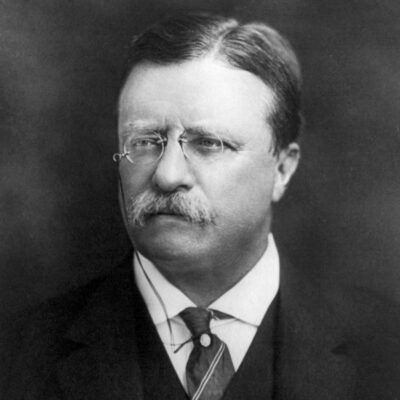
A Photo Portrait Of Teddy Roosevelt Hawaii Is Not The Only State That Produces Coffee. Hawaii is best known for its world-famous Kona coffee originally grown in the Kona region of the Big Island. With its tropical climate and areas of mountainous terrain, Puerto Rico offers suitable conditions for coffee growing. Recently, in Southern California, small coffee-growing farms produce experimental coffees which are quite pricey.

Hawaii Was the First State to Grow Coffee Commercially In The US The Coffee Grounds Can Beautify Your Skin. Coffee grounds can lift off dead skin cells, making skin feel smooth and look fresh. Caffeine is believed to improve blood circulation in the skin. A few cosmetics brands use coffee grounds in their beauty products, though there has not had enough clinical data on its use in topical products.

Hawaii Was the First State to Grow Coffee Commercially In The US Coffee as Biofuel. Scientists are turning the oil from waste ground coffee into biodiesel. One day coffee may be fueling some lucky ones’ cars, it might be a better alternative to EVs. People get to enjoy the coffee aroma from the car exhaustion mufflers.

Coffee Biofuel May Be A Reality In the Near Future Cream Keeps Your Coffee Warm Longer. Coffee stays warm 20% longer when adding cream. Simply, because the cream thickens the coffee, and adds viscosity, so coffee evaporates slower, avoiding a lot of heat loss. Beethoven Might Not be A Torture to Baristas. Beethoven was a coffee connoisseur, he, sometimes, could have six cups of coffee a day together with Haidn who was his music teacher. The legend that he would count 60 beans exactly per cup before making his brew is more of a story than there is any real record or evidence .

The Only Oil Painting Of Beethoven By Joseph Karl Stieler Expensive Coffees From Cat Poop And Elephant Dung. In Indonesia, the local adorable weasel-like critter, the palm civet eats the coffee cherries. A unique fermentation process occurs as the beans (rather seeds, to be precise) travel through the civet’s digestive tract. Some brave coffee farmer collects the beans from the civets’ droppings. This special coffee, after roasting, has a smooth finish and a very distinctive flavor to the final brew. Thus, Kopi luwak is known as "cat poop coffee." With prices ranging from about $100 to $600 a pound.

A Lovely Civet Cat Hanging From A Coffee Bush Branch Yet, the priciest coffee in the world is Black Ivory Coffee. It costs about $1000 and up per pound. This coffee is produced from part-digested coffee cherries eaten and defecated by Thai elephants . Oldest Cat Ever Loves Coffee. The "Oldest Cat Ever," a 38-year-old cat named Creme Puff, according to the Guinness World Record, drank coffee every week her whole life . Its owner, Jake Perry also raised another long-life cat, a 34-year-old, named Grandpa Rex Allen. Jack fed the same diet to Grandpa Rex Allen. This might be a coincidence, considering the average cat’s life is about 18 years. How Much Coffee Do Americans Drink A Day? Americans consume about 400-600 million cups of coffee every day, which is about 2 to 3 cups of coffee every American per day. Feel Gloomy? In a study of 263,923 people, the NIH (National Institutes of Health) and the AARP ( American Association of Retired Persons) found coffee may lower people’s risk of depression. Those who drank 4 or more cups of coffee a day were almost 10% less likely to become depressed than those who drank none .

A French Bulldog Lays Gloomily On A Piece of Dark Rug 100 Cups Of Coffee May Kill A 150-Pound Person. Medical studies estimate that roughly 10 grams or more of caffeine would be a lethal dose for an average 150-pound adult. 10 grams of caffeine equals 100 cups of coffee to be down in a very short period . Bees Love Coffee. Coffee plants have very sweet nectar-like flowers that are pollinated by bees. The flower also contains caffeinated nectar .

A Bee Is Busily Feeding On The Nectar of A Coffee Bush Flowers You Don't Need To Drink Coffee In The Morning. The human body produces cortisol naturally as soon as one wakes up. Drinking coffee first thing in the morning tricks our body into producing cortisol when it doesn’t need it. It is better to have a cup of coffee after lunch when one’s cortisol level drops and feels less alert and energetic . Coffee Shops Boost Your Creativity. The coffee shop's aroma and the soft background music may help people to think creatively. The coffee smell plus the atmosphere increase a person's openness and encourage a flexible mindset. Read the full article
1 note
·
View note
Link
Stationary energy storage and automotive applications to drive the global fuel cell market at > 20% CAGR from 2019 to 2026. Asia Pacific dominated the...
#adroit market research#global fuel cell market#alkaline fuel cell (afc)#low temperature fuel cells (lt
0 notes